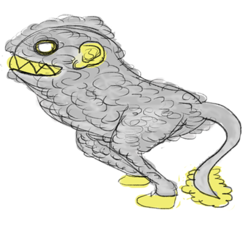Lurking Lamchorb: Difference between revisions
(Removed redundant notes, changed to new infobox) |
m (Text replacement - "Enemy dummy icon.png" to "Enemy icon.png") |
||
| (11 intermediate revisions by 2 users not shown) | |||
| Line 1: | Line 1: | ||
{{ | {{PEoE}} | ||
{{infobox PEoE | {{infobox PEoE | ||
|image=PEoE Lurking Lamchorb.png | |image=PEoE Lurking Lamchorb.png | ||
|size=250px | |size=250px | ||
|icon= | |icon=Enemy icon.png | ||
|name=Oberro agnus | |name=Oberro agnus | ||
|family=Lambchorb | |family=Lambchorb | ||
| Line 21: | Line 21: | ||
}} | }} | ||
The '''Lurking Lamchorb''' is the first enemy encountered in ''[[Pikmin: Echoes of Eternity]]'', found in the [[ | The '''Lurking Lamchorb''' is the first enemy encountered in ''[[Pikmin: Echoes of Eternity]]'', found in the [[Placid Plains]]. It is bipedal, however, it is built like a quadruped, so it struggles with certain movements. Even though it is slow, it packs a punch when encountered. Lurking Lamchorb usually graze in patches of [[Cattlegrass]], which keeps them occupied and not alert to the Captains or Pikmin. However, if one is not around any grass, it will be very alert. | ||
Not only does it eat [[Pikmin family|Pikmin]], but it uses its tail to stun Pikmin, making them an easy meal. It has exceptional hearing due to its large ears, having a range of detection about that of an [[Orange Bulborb]], when not occupied. Its weak spot is the sides, as it is slow to rotate. Throwing Pikmin on its legs will slow it down even further, but if it knocks the Pikmin down, it will attempt to eat them. When the Pikmin are stunned, it is best to whistle them back repeatedly until they become normal again. | |||
===Notes=== | ===Notes=== | ||
{{notes|Encyclopaedia animerros|Oberro agnus, kingdom Animalia, phylum cannicus, class vegeterri, family lamchorb. This bipedal organism seems to have a vestigial torso structure accommodating a quadrupedal configuration. It is estimated that 300 million years ago a common ancestor began to lose its back legs, due to environmental pressure, and success using its tail to catch prey. Being a herbivorous heterotroph, oberro agnus feeds on plant matter. However, due to seemingly predatory adaptations, one can surmise the existence of a mobile, hostile plant prey. Such a discovery leads to more questions...}} | |||
{{clear}} | |||
{{navboxes| | |||
{{PEoEnav}} | |||
}} | |||
[[Category:Eating enemies]] | [[Category:Eating enemies]] | ||
[[Category:Pikmin-altering enemies]] | [[Category:Pikmin-altering enemies]] | ||
[[Category:Pikmin: Echoes of Eternity enemies]] | |||
Revision as of 16:57, 7 March 2024
|
This article or section presents information pertaining to Pikmin: Echoes of Eternity, a fanon game created by Zoadra. |
| |||
|---|---|---|---|

| |||
| Scientific name | Oberro agnus | ||
| Family | Lambchorb | ||
| Weight | 10 | ||
| Max. carriers | 20 | ||
| Seed worth | 10 | ||
| Attacks | Eats Pikmin, stuns Pikmin | ||
| Taxonomy | |
|---|---|
| Note: all or most of this information may be fanon information. | |
| Kingdom | Animalia |
| Phylum | Cannicus |
| Class | Vegeterii |
| Family | Lamchorb |
| Genus | Oberro |
| Species | Agnus |
The Lurking Lamchorb is the first enemy encountered in Pikmin: Echoes of Eternity, found in the Placid Plains. It is bipedal, however, it is built like a quadruped, so it struggles with certain movements. Even though it is slow, it packs a punch when encountered. Lurking Lamchorb usually graze in patches of Cattlegrass, which keeps them occupied and not alert to the Captains or Pikmin. However, if one is not around any grass, it will be very alert.
Not only does it eat Pikmin, but it uses its tail to stun Pikmin, making them an easy meal. It has exceptional hearing due to its large ears, having a range of detection about that of an Orange Bulborb, when not occupied. Its weak spot is the sides, as it is slow to rotate. Throwing Pikmin on its legs will slow it down even further, but if it knocks the Pikmin down, it will attempt to eat them. When the Pikmin are stunned, it is best to whistle them back repeatedly until they become normal again.
Notes
Encyclopaedia animerros
- “Oberro agnus, kingdom Animalia, phylum cannicus, class vegeterri, family lamchorb. This bipedal organism seems to have a vestigial torso structure accommodating a quadrupedal configuration. It is estimated that 300 million years ago a common ancestor began to lose its back legs, due to environmental pressure, and success using its tail to catch prey. Being a herbivorous heterotroph, oberro agnus feeds on plant matter. However, due to seemingly predatory adaptations, one can surmise the existence of a mobile, hostile plant prey. Such a discovery leads to more questions...”
| Pikmin: Echoes of Eternity | |
|---|---|
| Enemies | Acidic Toxibeetle • Blue Beevorb • Earthfin Dolfsheep • Herding Aquanine • Lurking Lamchorb • Maggrub • Noxious Stagren • Stone Turrtugo • Sulking Sneedle • Volcanic Toxibeetle |
| Bosses | Giant Acidic Toxibeetle • Prime Blue Beevorb |
| Flora | Hardstem • Rockshroom • Bluestem • Tall Fescue • Radiant Dandelion • Cattlegrass • Verdant Vine |
| Locations | Placid Plains (Beevorb Tunnel • Tin Labyrinth • Kansa Basilica) • Voranoth Isles |
